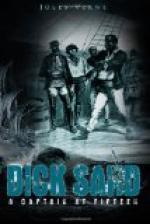The court was alcoholized to the last chief, and incessantly imbibed strong beer, cider, and, above all, a certain drink which Alvez furnished in profusion.
Moini Loungga counted in his harem wives of all ages and of all kinds. The larger part of them accompanied him in this visit to the “lakoni.”
Moini, the first, according to date, was a vixen of forty years, of royal blood, like her colleagues. She wore a bright tartan, a straw petticoat embroidered with pearls, and necklaces wherever she could put them. Her hair was dressed so as to make an enormous framework on her little head. She was, in fact, a monster.
The other wives, who were either the cousins or the sisters of the king, were less richly dressed, but much younger. They walked behind her, ready to fulfil, at a sign from their master, their duties as human furniture. These unfortunate beings were really nothing else. If the king wished to sit down, two of these women bent toward the earth and served him for a chair, while his feet rested on the bodies of some others, as if on an ebony carpet.
In Moini Loungga’s suite came his officers, his captains, and his magicians.
A remarkable thing about these savages, who staggered like their master, was that each lacked a part of his body—one an ear, another an eye, this one the nose, that one the hand. Not one was whole. That is because they apply only two kinds of punishment in Kazounde—mutilation or death—all at the caprice of the king. For the least fault, some amputation, and the most cruelly punished are those whose ears are cut off, because they can no longer wear rings in their ears.
The captains of the kilolos, governors of districts, hereditary or named for four years, wore hats of zebra skin and red vests for their whole uniform. Their hands brandished long palm canes, steeped at one end with charmed drugs.
As to the soldiers, they had for offensive and defensive weapons, bows, of which the wood, twined with the cord, was ornamented with fringes; knives, whetted with a serpent’s tongue; broad and long lances; shields of palm wood, decorated in arabesque style. For what there was of uniform, properly so called, it cost his majesty’s treasury absolutely nothing.
Finally, the kind’s cortege comprised, in the last place, the court magicians and the instrumentalists.
The sorcerers, the “mganngas,” are the doctors of the country. These savages attach an absolute faith to divinatory services, to incantations, to the fetiches, clay figures stained with white and red, representing fantastic animals or figures of men and women cut out of whole wood. For the rest, those magicians were not less mutilated than the other courtiers, and doubtless the monarch paid them in this way for the cures that did not succeed.
The instrumentalists, men or women, made sharp rattles whizz, noisy drums sound or shudder under small sticks terminated by a caoutchouc ball, “marimehas,” kinds of dulcimers formed of two rows of gourds of various dimensions—the whole very deafening for any one who does not possess a pair of African ears.




